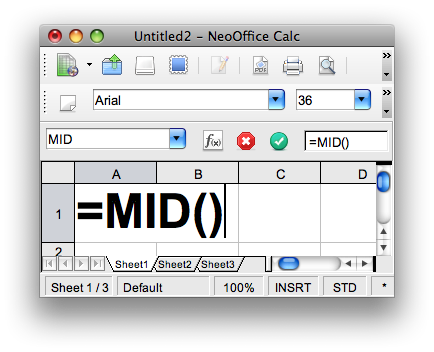< Previous lesson | Overview | Next lesson >
=MID()
Extracting a given number characters, counting from the point you specify

It could actually be done with =LEFT() and =RIGHT() in conjunction with =LEN(), but that would be a little complex, esp. as long as we have the excellent formula =MID(), which we will show you here.

In cell A1 enter the following text: [This is a test of =MID()]

In cell A3 enter the following, like shown above: [=MID(A1;6;2)]
What happens when you press [Enter]? You get the word [is], right?


In cell A4 enter the following, like shown above: [=MID(A1;10;5)]
What happens when you press [Enter]? You get the word [ test], right? This illustrates one of the dangers, if you can call it that, when dealing with text -- it appears to say "test", but it says " test" -- do you see the difference? There’s an extra space before the word "test", which to Calc is a completely different word than " test"!

OK, move on to some more explanations regarding the syntax...
Look at the syntax: [=MID(A1;10;5)]
Doesn’t this look quite similar to the =LEFT() and =RIGHT() syntaxes?
There is in fact just one difference, and that is the middle part, which says from which character you want to start the extracts.
A1 specifies that the text you want to extract is contained in the cell A1. You might just as well have replaced A1 with the text "This is a test of =MID()", encapsulated by the "-s at the beginning and end of the text. This is the same as the first parameter in the =LEFT() and =RIGHT() syntaxes.
10 specifies at which character you want to start the extract. This is the parameter that comes in additions to the two parameters in the =LEFT() and =RIGHT() syntaxes.
5 specifies the number of characters you want to extract, which is exactly the same as the last parameter in the =LEFT() and =RIGHT() syntaxes.
That’s it! You can now extract values from a string.